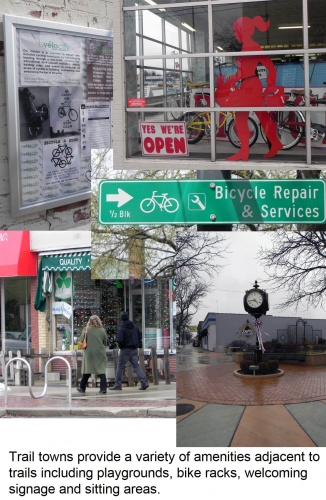Is your town a Trail Town?
Communities benefit from linkages through the recreational use of rivers and trails.
 Recreational trails provide many physical, economic, environmental and social benefits to a community. They can help encourage healthy lifestyles, bring customers into local businesses, protect wildlife habitats and promote a strong sense of community and place. As the number of recreational trails being built increases, it is important to understand how they fit into and shape our community identity. Trail Town is a concept started by the Allegheny Trail Alliance to explain how communities can leverage trail-based tourism and recreation for economic and community development in communities linked by trails.
Recreational trails provide many physical, economic, environmental and social benefits to a community. They can help encourage healthy lifestyles, bring customers into local businesses, protect wildlife habitats and promote a strong sense of community and place. As the number of recreational trails being built increases, it is important to understand how they fit into and shape our community identity. Trail Town is a concept started by the Allegheny Trail Alliance to explain how communities can leverage trail-based tourism and recreation for economic and community development in communities linked by trails.
Recently, a group of 60 people gathered in Flat Rock, Michigan at the Michigan Recreation & Parks Association Trail Summit, for a mobile workshop sponsored by Michigan Sea Grant Extension that explored the concept of becoming a Trail Town. Trail Town experts from the Land Information Access Association (LIAA) led participants on a tour along portions of the Downriver Linked Greenways trail system through Flat Rock, Brownstown, Rockwood, Gibraltar and Trenton in southeast Michigan. LIAA explained the Trail Town concept and showed examples utilized in the area. Workshop participants learned that the most successful Trail Towns are those communities that are active, attractive and interesting places with accessible and comfortable spaces for trail users. Businesses and citizens are welcoming and provide physical amenities that support and encourage trail users to explore and enjoy their communities.
How can your town become a trail town?
According to LIAA, it is important to get organized. Start by forming a team of highly motivated and committed individuals from the community. Individuals can include representatives from local businesses, downtown development authorities, civic groups, financial institutions, trail organizers, government officials and other interested citizens. Once formed, the team should do a thorough inventory of the downtown or central business district and its relationship to the trail. This will include determining the type of trail(s) (hiking, biking, equestrian, kayaking, etc.) near the downtown or central business district; understanding the geography between the trail and the downtown area; and identifying and assessing trail heads, signage, and other trail amenities such as bike racks, benches, drinking fountains and restrooms.
For help establishing a community group or exploring the feasibility of creating a trail, contact Mary Bohling bohling@anr.msu.edu or 313-757-7356 x 101.



 Print
Print Email
Email



